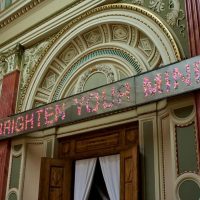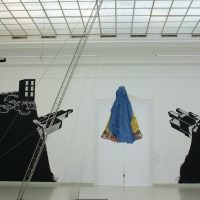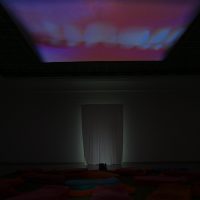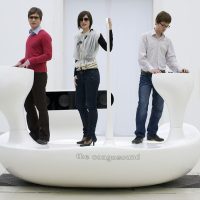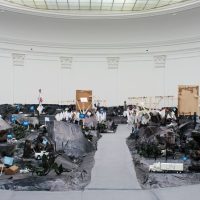világító panel I luminent panel, 68 x 780 cm
fotó: Surányi Miklós
installáció, vegyes technika / installation, mixed media
fotó: Surányi Miklós
videóinstalláció, vegyes technika / videoinstallation, mixed media
fotó: Surányi Miklós
installáció / installation, 230 x 310 x 215 cm
fotó: Surányi Miklós
Videóinstalláció, vegyes technika / Video installation, mixed media
installáció, vegyes technika I installation, mixed media
fotó: Surányi Miklós
3 színes fotó / 3 color photos, 150 x 195 cm each
Art encourages empathy and offers some help to understand the complex texture of life, to see the essence of things, and as such, has an important role in our attempts to make sense of the world. Petals falling from a tattooed body; a blood donor centre and sushi bar at work; a huge sand table, where you can walk on the locations of wars; the enchanting movement of a dervish costume as it falls far from above; an old man’s dance in a park in Amsterdam; actresses’ moving confessions about motherhood; erotic fertility rites from the Balkans: these surprising, humorous, tragic, disturbing or poetic works – drawings, paintings, murals, films, photos, video works, installations – show how today’s artists relate to everyday life and extreme situations.
Body and soul, intellect and emotions, pain and passion, rite and revolt, father and son, mother and lover, friend and foe, war and revival, heaven and hell: the exhibition invites the viewer on a journey during which these “extremes” of the experiences one can have in this world become visible side by side, complete with parallels and contradictions. The display features disturbing works that objectify emotions, as well as social projects that are straightforward, positive artistic statements. Nor are more ambiguous works absent, where pain and pleasure engages in the kind of dialogue we experience every day. Such eternal and intricate subjects are treated as love, friendship, politics, experience and time, while the issues touched upon include nostalgia, hedonism or women’s fictitious worlds.
The bizarre, absurd, brutal and at the same time comical world of human obsessions are also here for the viewer to ponder on. Finally, we are offered very critical statements about such aspects of human life as violence, war or the abuse of women’s rights. These works, however, do not restrict themselves to presenting aggression or cruelty, because the candid moral standpoint and action of the artists also outline a sense of hope. The diverse perspectives and approaches eventually add up to a whole, and Mi Vida tries to formulate a single message, rising above the particular facts of the individual works, that the moral values of humanity are constant.
The display will be accompanied by side events, such as a special screening from MUSAC’s Video Collection in Menu Point gallery, related to the exhibition theme. The catalogue, which includes reproductions of the exhibited works and texts by the curators, will be edited in English and Hungarian.
